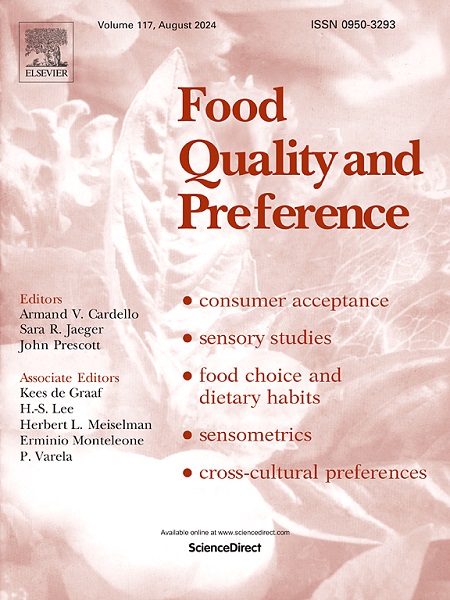Understanding perceptions of unfamiliar drinks using natural language in simulated drinking contexts
IF 4.9
1区 农林科学
Q1 FOOD SCIENCE & TECHNOLOGY
引用次数: 0
Abstract
How do people make sense of new foods and beverages? Hop water is a recent example of a novel beverage category, advertised as either an alcohol-free, zero-calorie beer alternative or a more “natural” alternative to flavored seltzers. This study aimed to understand what individual or contextual factors may cause consumers to perceive hop water as more beer-like or more seltzer-like. Participants (43 regular seltzer-drinkers, 41 regular beer-drinkers, 45 people who regularly drink beer and seltzer, and 68 people who do not regularly drink either) tasted three commercially-available hop waters in one of three drinking contexts (apartment garden, outdoor bar, or office breakroom) simulated using 360° video projection. A series of open-ended questions elicited descriptions of product perception, similar products, and potential drivers of (dis)liking.
Parallel to this, we analyzed descriptions of typical beers, seltzers, and other drink categories from 518 online survey responses with Correspondence Analysis to define a Beverage Category Space. This allowed us to calculate beer-likeness and seltzer-likeness scores for common vocabulary words. The descriptions given during immersive tasting were projected into the Beverage Category Space as supplemental variables to determine their beer-likeness and seltzer-likeness. In the bar, participants more often compared the drinks to beer, while in the breakroom, participants focused more on carbonation. Regular beer-drinkers described the products as less beer-like than regular seltzer-drinkers. These findings suggest that consumers tasting unfamiliar products may assimilate expectations cued by eating or drinking context, but experience contrast effects from expectations based on similar familiar products.
在模拟饮酒情境中使用自然语言了解对陌生饮品的看法
人们如何理解新食品和饮料?啤酒花水是最近出现的一种新型饮料,它被宣传为一种不含酒精、零卡路里的啤酒替代品,或者是一种更 "天然 "的风味苏打水替代品。本研究旨在了解哪些个人或环境因素会导致消费者认为啤酒花水更像啤酒或更像苏打水。参与者(43 位经常饮用苏打水的人,41 位经常饮用啤酒的人,45 位经常饮用啤酒和苏打水的人,68 位不经常饮用啤酒和苏打水的人)在 360° 视频投影模拟的三种饮用环境(公寓花园、户外酒吧或办公室休息室)中品尝了三种市面上销售的啤酒花水。与此同时,我们利用对应分析法分析了 518 份在线调查回复中对典型啤酒、苏打水和其他饮料类别的描述,从而定义了饮料类别空间。这样,我们就可以计算出常见词汇的啤酒和苏打水喜爱度得分。在沉浸式品尝过程中给出的描述作为补充变量被投射到饮料类别空间中,以确定它们的啤酒好感度和苏打水好感度。在酒吧,参与者更多地将饮料与啤酒进行比较,而在休息室,参与者则更多地关注碳酸化。与经常饮用苏打水的人相比,经常饮用啤酒的人认为这些产品不太像啤酒。这些研究结果表明,消费者在品尝陌生产品时,可能会吸收由饮食环境所引起的期望,但会体验到基于类似熟悉产品的期望所产生的对比效应。
本文章由计算机程序翻译,如有差异,请以英文原文为准。
求助全文
约1分钟内获得全文
求助全文
来源期刊

Food Quality and Preference
工程技术-食品科技
CiteScore
10.40
自引率
15.10%
发文量
263
审稿时长
38 days
期刊介绍:
Food Quality and Preference is a journal devoted to sensory, consumer and behavioural research in food and non-food products. It publishes original research, critical reviews, and short communications in sensory and consumer science, and sensometrics. In addition, the journal publishes special invited issues on important timely topics and from relevant conferences. These are aimed at bridging the gap between research and application, bringing together authors and readers in consumer and market research, sensory science, sensometrics and sensory evaluation, nutrition and food choice, as well as food research, product development and sensory quality assurance. Submissions to Food Quality and Preference are limited to papers that include some form of human measurement; papers that are limited to physical/chemical measures or the routine application of sensory, consumer or econometric analysis will not be considered unless they specifically make a novel scientific contribution in line with the journal''s coverage as outlined below.
 求助内容:
求助内容: 应助结果提醒方式:
应助结果提醒方式:


